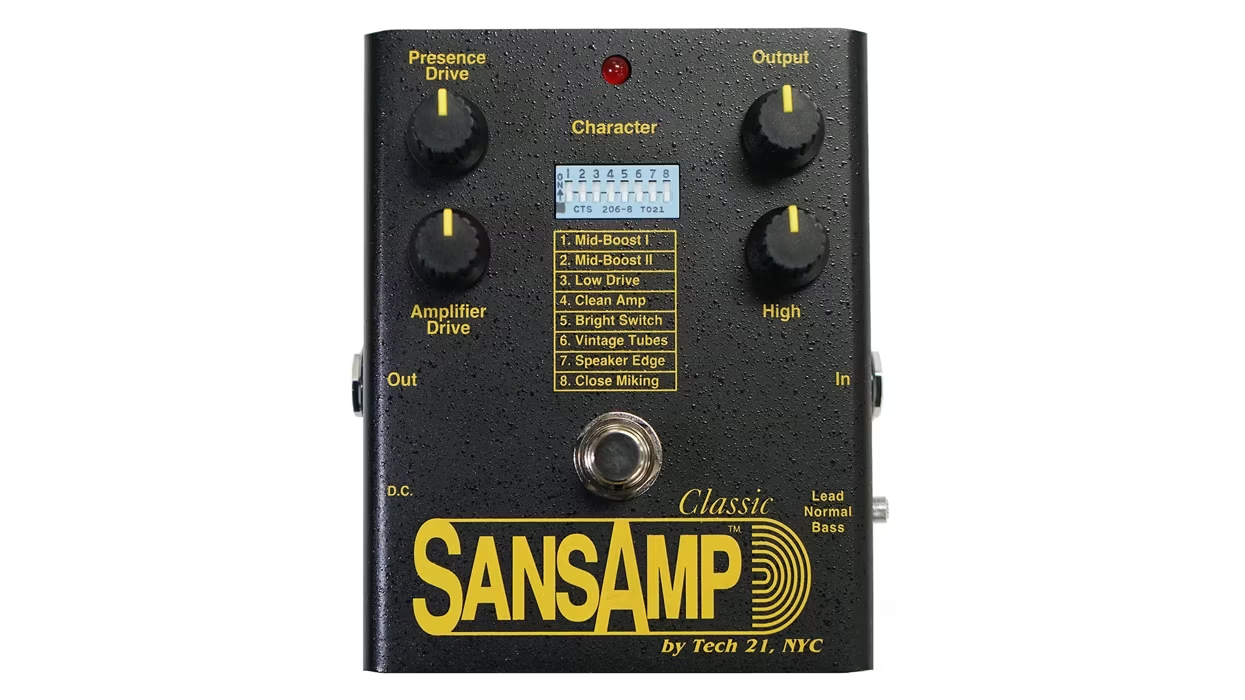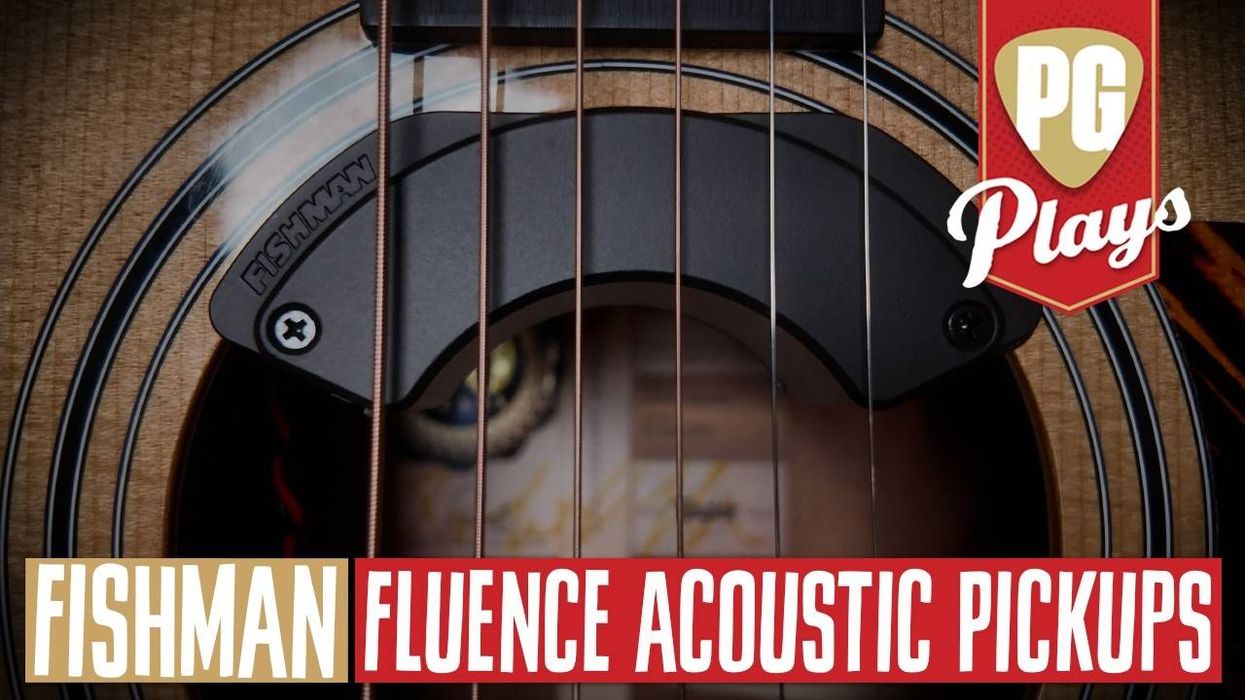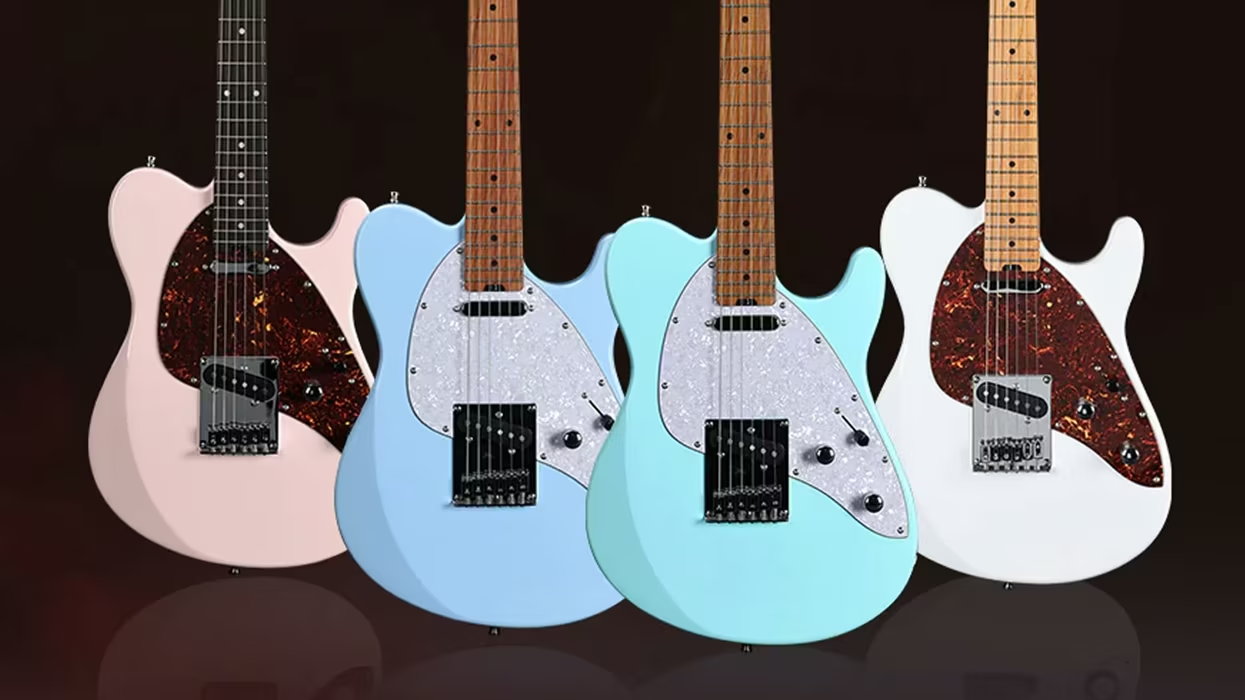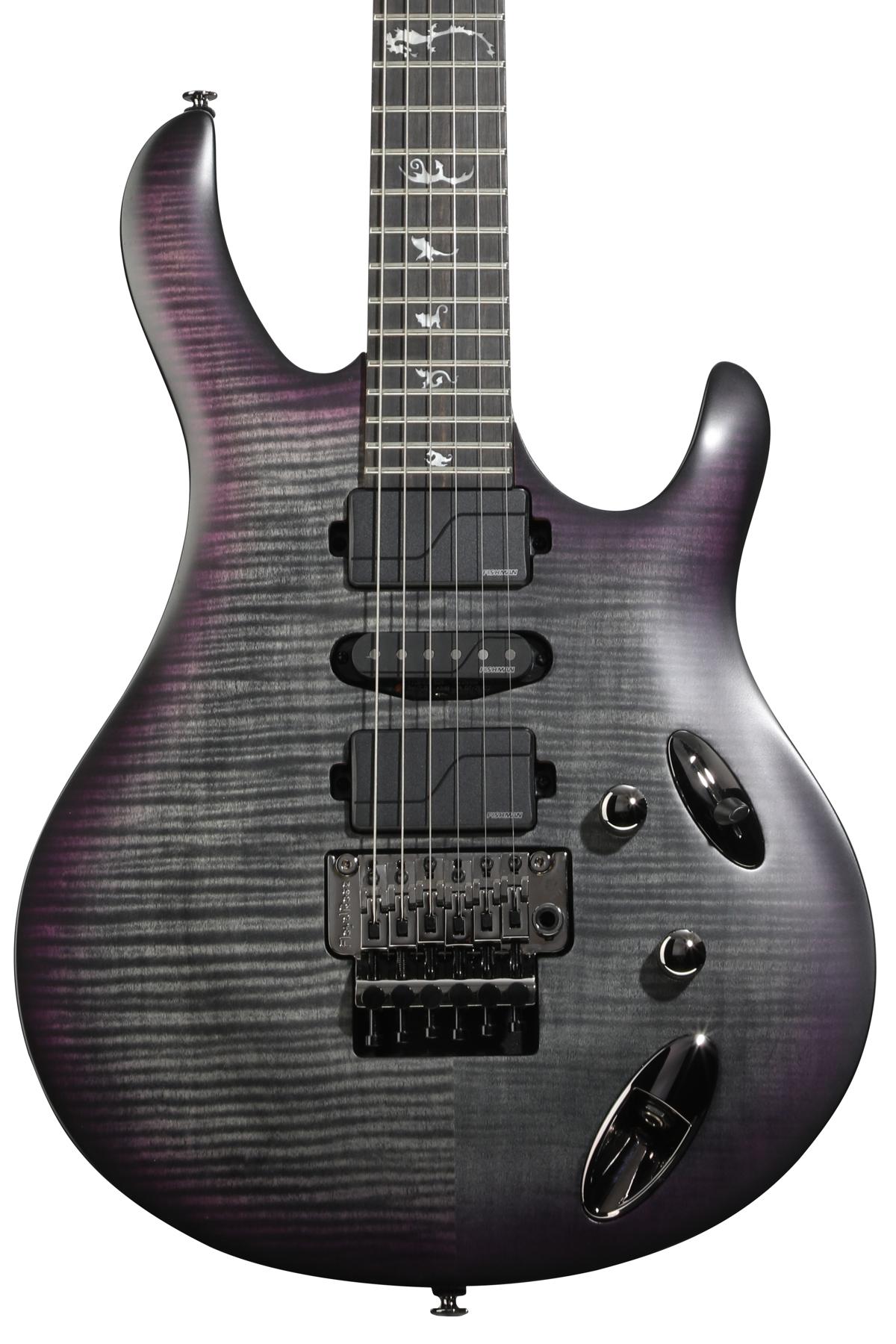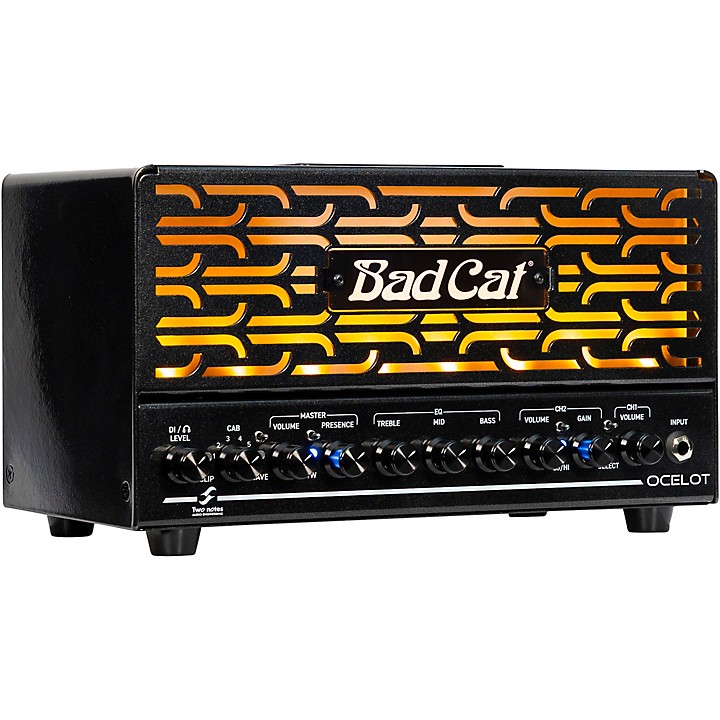There''s a new amp company that is positioning itself to take the blues scene by storm. In fact, Category 5 amps were originally made specifically for blues players. You''ve already heard them if you''ve seen Joe Bonamassa or Jimmy Thackery lately; the amps have also held up the back line at a number of blues festivals and award shows.
So, why haven''t you seen ads or reviews for these tone monsters named after tropical storms? Well, that’s part of their master plan.
Category 5 has spent the last two and a half years carefully crafting both an expansive line of boutique amps and their own identity. They''ve also helped natural disaster charities Feed the Children and Voice of the Wetlands by donating ten percent of the proceeds from their amps.
After gaining notoriety in the blues sector, with established veteran bluesmen and up-and-comers alike behind their products, Cat-5 is poised to expand into a larger market. In this exclusive interview, we sat down with Cat-5''s Director of Artist Relations, Don Ritter, and Director of Product Development, Steven Scott, to talk about their ever-expanding 14-amp line, their unconventional approach to the business and how Cat-5 isn’t just for bluesmen anymore.
How did you get into this business?
SS: I started doing this around 2001 as kind of a hobby. I’d actually built a few before that because my vintage amps were breaking down when I was gigging. I started off cloning my own amps so that I could have reliable amps, and then people started playing them and asking about them, and it just kind of caught on. I was doing a couple per month, here and there, and I kept that going until 2004, when I met Don.
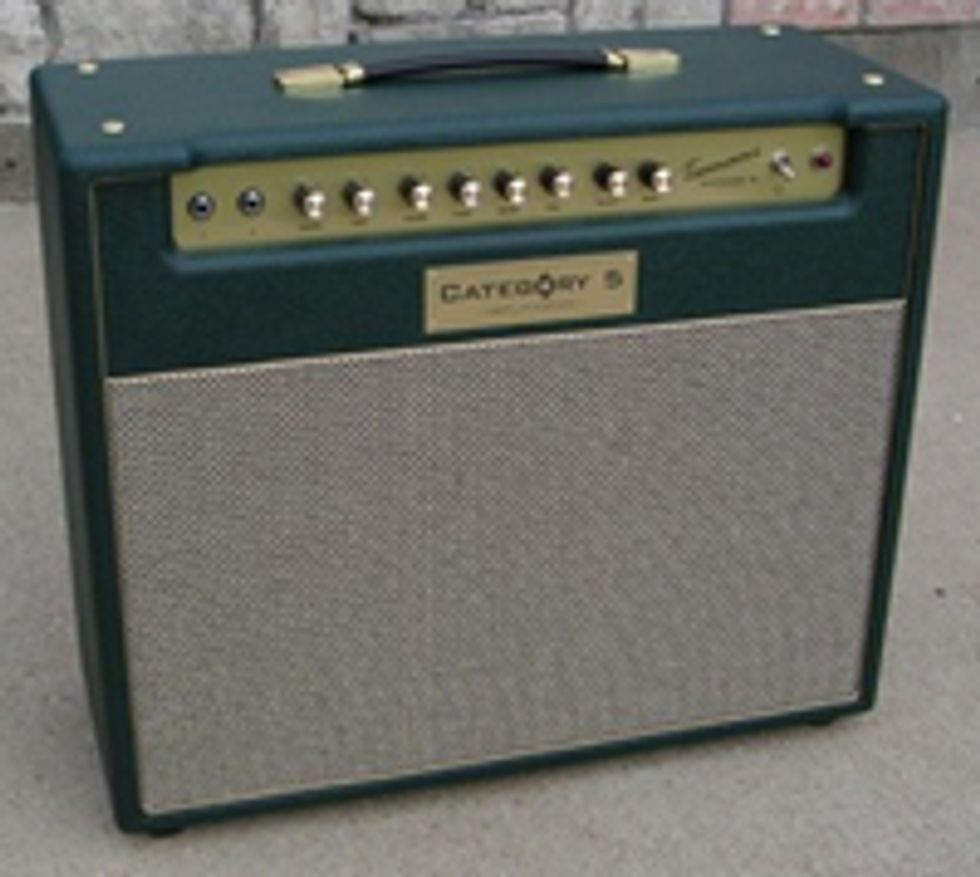 The Category 5 Tsunami |
So this is where the storm-related names came about?
SS: Yeah, it just kind of stuck that we would keep going with the storm-type stuff and try to keep the awareness out there. We had targeted some charities that were more helpful than not during those tragedies, Feed the Children and Voice of the Wetlands, so we continue to try to draw attention to that and donate money to the charities, and give them some public credit for what they’re doing.
Where do you see your amps fitting in this vast musical landscape?
DR: Essentially, we are providing the touring artist – or pretty much anyone – with a reliable amp that gives them a lot of the vintage-type tones that they want, without having to take their vintage amps on the road. Or for musicians with vintage amps that are a bit unreliable in a touring situation, this is an alternative where they can get the sounds that they’re after, and still have some modern features, especially in terms of controlling the tone in different volume situations.
So these are mainly targeted at touring musicians?
DR: Well, we would like anyone who loves guitars to want one, but they’re built so that they’re rugged and can deliver the tone in a variety of venues. We started in the blues world deliberately. We knew there are a variety of club sizes that blues artists play in. They can play for 50 people to 5000 people, and everything in between, all in the same week, 200 nights a year. That was a pretty challenging environment to build an amp for, so we kind of used the blues world as a test bed. If we could build an amp that could withstand the punishment there, then it should be fine everywhere else. But we also made the decision to target blues because it’s a genre of music that when you ask a bunch of people what they play at home, they’re always saying, ‘I play some blues, a little bit of classic rock.’
You’re pretty steeped in the blues world, but you do have one rock amp, right?
DR: Yes, the 1900 is pretty much a pure rock amp, but there’s also one side of two other amps, the Allen model and Isabelle model, that have a higher gain, kind of hot-rodded Plexi sound to them.
We should probably clarify; just about all of your amps have two distinct channels, almost two separate amps in one.
SS: Our philosophy on the two channels is that a lot of amps have a clean channel and a dirty channel, and one sounds good and the other doesn’t. We want to provide two distinctly different tones that are both good, useable tones, then add some versatility to it. For example, some of our amps have a separate effects loop on each channel, so you can run two effect chains depending upon what you’re doing. Our channel switching is done with an A/B box on the floor, so we don’t have to add any noise or complexity inside the amp and circuit boards. So with the two channels we’re trying to get, almost like what you said, two amps in one box, but we’ve paid attention to both channels so they both sound the best that they possibly can.
DR: All of the amps have this, except the 1900. And that one has a gain control with several different characters. It can play nice and clean, and if you crank up the gain, it becomes a completely different animal. So it’s not exactly a two-preamp-type amp, but it can cover a lot of ground from that aspect.
So are you looking to move into the rock scene a bit more?
DR: We will eventually, but more importantly, I think our next area of focus will be country musicians.
Do you have an amp specifically geared toward that?
DR: Actually, our hybrid amps, the Allen and the Isabelle, which have a very clean, Fender-type tone on one channel, which is kind of the mainstay of country players, and the other side is this kind of Marshall-esque, Plexi-type tone, with an adjustable gain that lets you take it to more of a hot-rodded JCM-800 kind of tone and beyond. We’ve found what really works well for today’s country music is switching back and forth between the channels on those amps. Instead of stomping on a stomp box to get distortion into the front end of a Fender amp, they’re just switching over to the other channel of this amp and it’s giving them everything they want for this newer-type country lead tone. And then they’re right back where they want to be for some of the more traditional tones. So we just had that amp demoed by a few country players who gave us extremely good feedback, and we’re looking forward to that one being the lead amp into the country side.
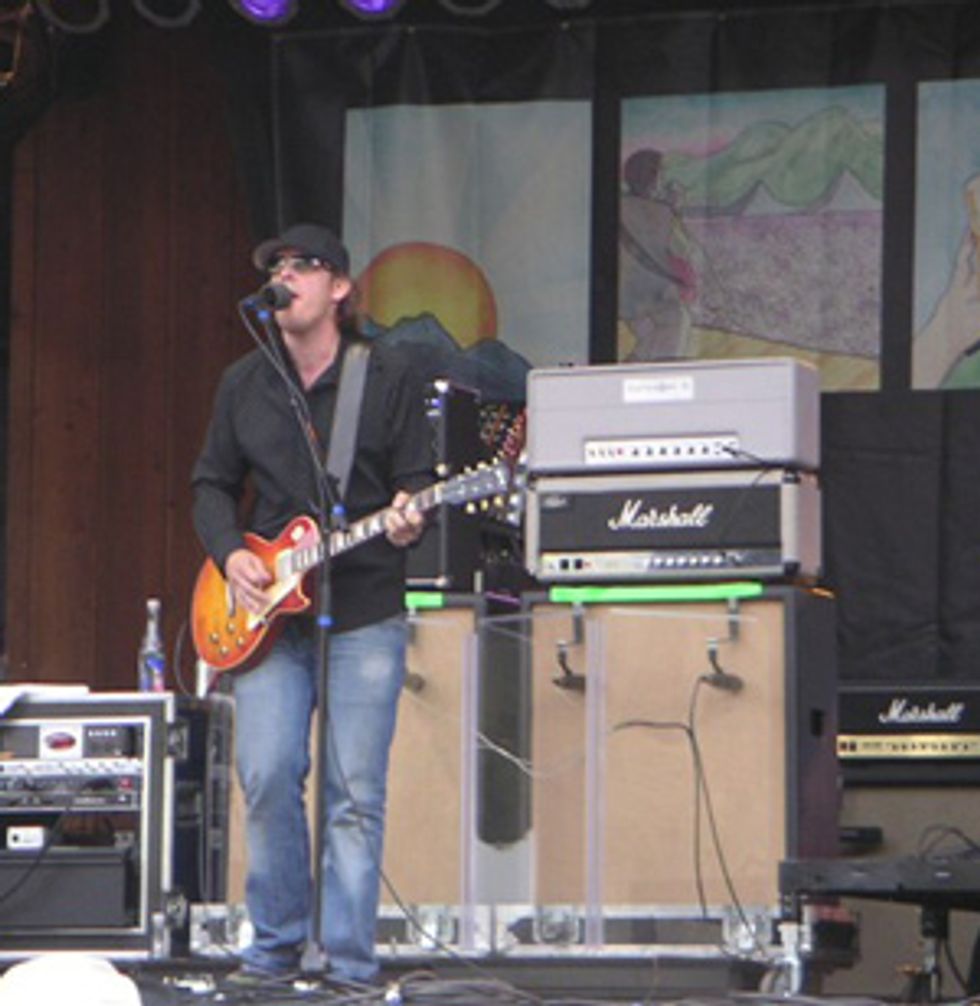 Joe Bonamassa playing through a Category 5 at the 2007 Telluride Blues and Brews Festival |
DR: I’ve had some contacts in Telluride – I own a house up there – so I approached some people that I knew and got the product vetted by the [Telluride Blues & Brews Festival] promoters and sound guys to make sure it was something they wanted to have up there. At first they just said, ‘bring an amp, we’ll make sure somebody plays it, maybe we’ll put one in the artists’ green room.’ So I talked to the production guy and sent him some specs, and he was interested and told us to bring a few up. We showed up at our first festival with nine amps and no idea whether anyone was going to play them or not. But 15 of the 17 national acts used our amps at that festival.
Also, Joe Whitmer, Producer of the International Blues Competition and Blues Music Awards, definitely helped us get in front of the greatest blues fans and artists in the world.
Do you have any festivals coming up?
DR: Yeah, we’re backlining Blues from the Top in Winter Park, Colorado, coming up at the end of June with Johnny Winter, Joe Bonamassa and Jimmy Thackery – it’s going to be a real nice blues festival.
Are these festivals how you got hooked up with all of your endorsing artists?
DR: That’s how we got started, although we started a separate conversation with Tab Benoit because of the Voice of the Wetlands and his involvement in hurricane relief. When you look at our list of folks, they’re all interested in giving back in some respect. Jimmy Thackery and Joe Bonamassa are big in the Blues in the Schools program, so we’ve picked up that charity along with the hurricane relief.
We have to give a special thanks to John Richardson, he was our first artist and was very instrumental in the development of our first three models. A lot of our other contacts came through John Catt from the Grand County Blues society, who is also the founder of the Blue Star Connection, which gives musical instruments to terminally ill children, and is one of our new charities this year.
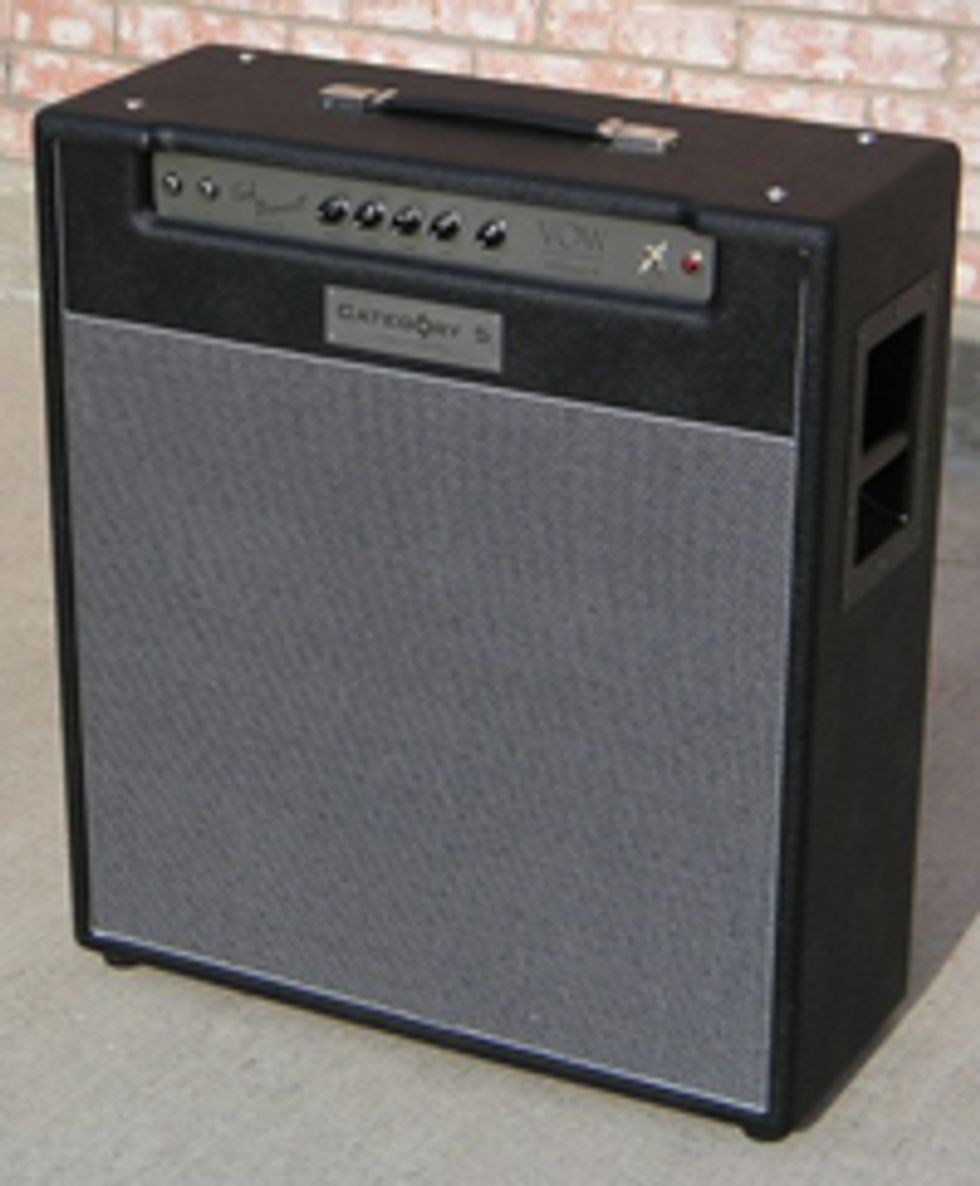 |
So is that one of the models?
DR: That is now a Tab Benoit Signature. We just finished the development on that and got it to where he is absolutely pleased with it, and so we’re now offering that in a signature model.
You have a Joe Bonamassa model as well, right?
DR: Right, we have Joe Bonamassa signature model that’s based on a 1968 Super Lead, so it will cover a lot of rock ground and a lot of classic rock.
How much input does the artist have with these signature models?
DR: With the Joe Bonamassa one, he had tried the 1900, but it wasn’t enough wattage and it didn’t fit into the realm of tone that he was after. So I asked what he was looking for and he said, ‘Well, if you could do this… build a 1968 early transition model Marshall Super Lead with a Double-style mid boost, an effects loop like in the Marshall Jubilee, tighten up the bottom, make the top nice and creamy, and add really pronounced mids… that might work.’
It was like, ‘Here’s my dream, see ya later!’ So we went off and built the amp, and he came down to the Dallas Guitar Show where we had it ready. He plugged into it and played it for a few minutes, and he put the guitar down and ran over to get one of the effects pedals that he had somewhere else and he played it a few more times, and he just looked at us and said, “I can’t believe it. It was exactly what I described.”
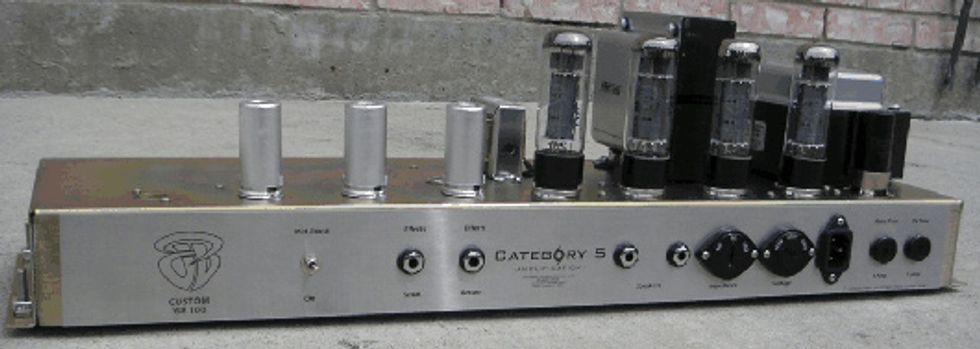 |
Wow, no tweaking from him or anything?
DR: Nope, no tweaks. That was it. He went to Europe a few months later and wanted another one, but we couldn’t get it done on time. We said we’d have another ready for him when he got back, and he was a bit reluctant because he really liked that one. But he took it, and we found some NOS silver Jubilee cloth and built a second one. After he came back and got the second one, I got a call from him saying, “It’s one thing when you can build a fantastic amp. It’s a completely different thing when you can build two exactly the same.” So that was a really great compliment from Joe.
And that became his signature model?
DR: Yes, that’s his signature model.
Neither the Joe Bonamassa nor the Tab Benoit is on the website, right?
DR: No, we’re actually right in the middle of a website update and so we’ve got a bunch of models that aren’t on the website yet that we’ll have up hopefully in the next few weeks. Still, [the Bonamassa amps] are starting to gain some popularity – I’ve taken orders for four of them this week. We just get a lot of people who see Joe play and see something that they haven’t seen before or haven’t heard before.
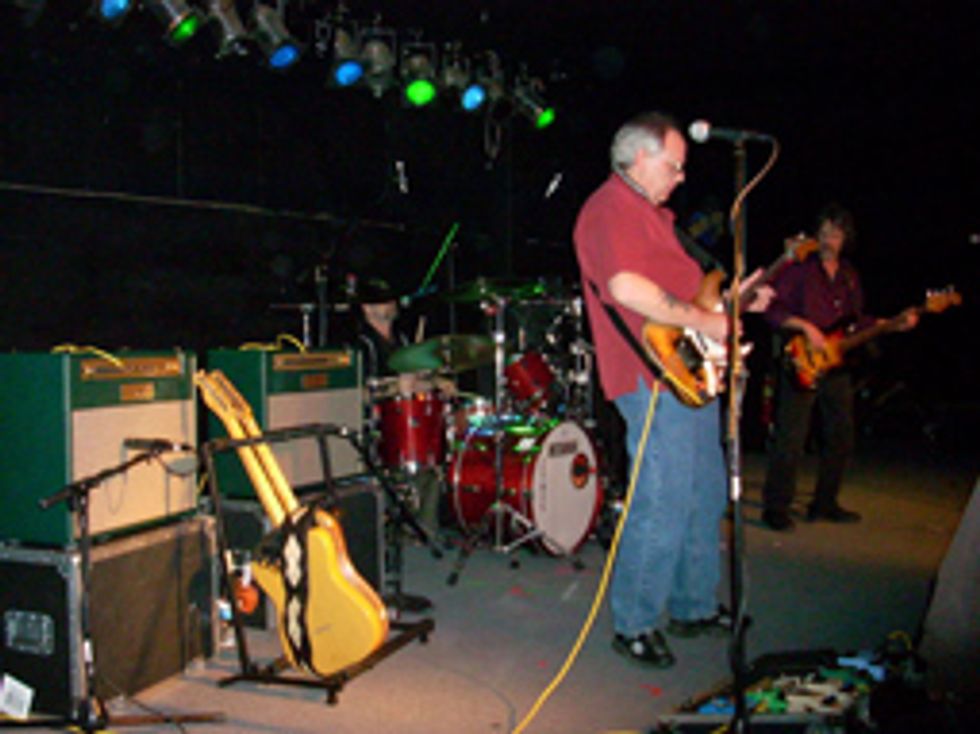 |
DR: We just sent Jimmy Thackery his two new amps. He played demos for six months, and said, ‘I need a little bit of extra power in one of the amps, no change to the tone, and for the other amp I need a significant bump in power and a little different tone on one channel.’ So we just built those for him.
So those are going to be his signatures?
DR: One amp is going to be his signature, the other amp is a stock Andrew, but we increased the wattage to 50 watts. His signature model is called Typhoon Joe, named after his father actually.
Seems like you guys are great at filling specific requests for these guys – what was Jimmy looking for?
DR: Well, the conversation I just had with him, he’s been in three different venues over the last three days with the amps. One was a kind of 400-seat, medium club, more of a listening type environment, and he had them up about halfway. The next night was a big rock club with 1200-1500 capacity and he had them up about 3/4 of the way. And the next night was in an 80-seat auditorium next to a church. He’s good friends with a Catholic priest, so he played a little venue for them, and had the amps on about 2 or 3. He was able to have consistent tone over those three gigs, plus he’s got the stage volume for the outdoor festivals where he’ll crank the power scaling all the way up. That’s really what we’re after; that’s really what’s different.
Is that kind of versatility found in all of your amps?
DR: Yeah, we like for both channels to have a very good clean and a very good distorted tone, which is also something different. It really does give you a lot of versatility, and that combined with our variable voltage (similar to power scaling or power dampening), allows those different tones to be used at different volume levels. So you can crank the amp up and get the good power tube distortion sound from it, but you can dial back with power scaling or power dampening, depending upon what bias you’re using, and get that same level of tone at a reduced volume level.
Plus, we can get a singing sustain in the amp without a lot of distortion or compression, which when combined with the variable voltage, allows a usable tone throughout the volume range versus just one sweet spot at one volume level. Those features are really what give versatility to the amps.
So how do you make all of these concepts a reality?
SS: We start with a concept. We don’t start with a specific amp – like, I’m going to build a JTM-45-type thing. We start from the ground up, designing circuits primarily from scratch. We do borrow a little bit here and a little bit there, but it’s more about crafting the sound, picking components and making design decisions that will accomplish what we’re trying to do. We’ve got some amps that we felt like really needed to breathe and be rich with harmonics and overtones, so we tried to accomplish that first before we even decided what its voice was going to be. And then once we accomplished that, we took the principles from that earlier excursion and turned it into a package that was pleasing to the artist, which is kind of interesting to me. Tab’s amp sounds a lot like a Super, but internally it’s not really anything like a Super.
What we’ve learned is that people are not really all that interested in innovation when it comes to guitar amps. You’ve got the Fender camp and you’ve got the Marshall camp, and they want the dials to do the same thing, they want the tone to be predictable, just better. And a lot of times they can’t even articulate what better is. You know, I’ve had people tell me that they want it to sound “more purple.”
It’s been a really interesting learning experience; when I built amps for myself, I was just kind of going for a sound and when I was done I was happy. You put the same thing in front of someone else, and they say, ‘I want my treble knob on six.’ Even though they can put it on four and get the same sound, they want the knob on six!
Is everything handmade in house?
DR: The cabinet work is subbed out, and in the future we will probably sub out a few small components, but the rest is handmade.
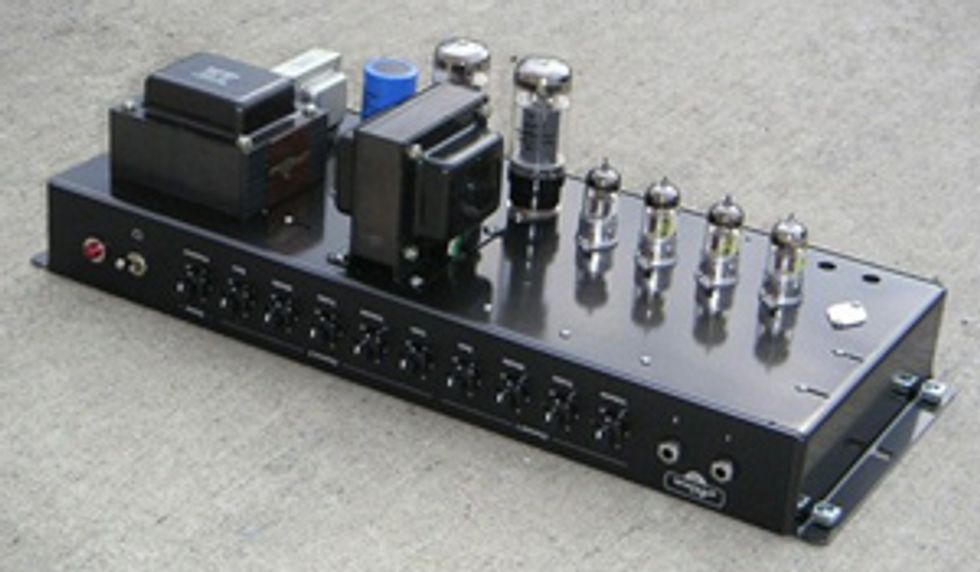 Chassis prototype for the Cat-5 Allen Hybrid |
DR: Well, one thing that helps is that we can build about nine or ten different amp models on the same chassis. We have four different platforms, or tone types, we can build on, and a tone circuit that can go from 20 watts to 50 watts to 90 or 100 watts, all within the same chassis. It really leads itself to being able to componentize the process and make it more efficient. The chassis then fits into a 1x12 or 2x12 or 2x10 or 4x10 or a head cabinet, so everything is very simplified, and we can get a lot of productivity out of what we’re doing.
Every amp ships with kind of a goodie bag… what’s in that?
DR: We usually send a t-shirt, a nice vinyl cover for the amp and some extra tubes. If you have a tube amp, the most unreliable part of a tube amp is the tube. That is something that we can’t screen out completely. We test everything, and we do a good job of doing the QA to make sure the amp ships out and everything is in good shape, but with guys that are rattling these things around in their truck 200 times a year, you have the occasional tube damage problem. We ship out an extra set of tubes so that these guys aren’t trying to figure out where the local Guitar Center is – there are a lot of places that don’t have a local Guitar Center. We don’t want them without at least the first line of defense.
A lot of the amps that we build 50 watts and below use cathode bias, which allows you to change tubes without changing the bias, so you don’t have to be an amp tech to field service the amp. Especially in models like Andrew and the Typhoon Joe amps, you can even try a whole box full of different types of tubes – KT66, 5881 or a 6L6 in the same amp and you get a whole variety of tone.
And they can do it themselves?
DR: Right. You can do it yourself, kind of have a little tone tasting party, all handled without a tech, and without messing with the voltages. Sometimes we’ll send a set of 6L6s, instead of an extra set of 5881s, so they’ve got two choices. It’s really a high-value package, and they’re not cheap, but they’re also not priced as high as some other of the boutique-type amps. I think they’re actually within reach of touring musicians. By no means do they not feel some pain when purchasing one, but there’s a big difference between $3000 and $6000. And I haven’t met anyone who’s told me there’s any difference in quality or tone for what we’re providing.
What’s next on your radar?
DR: One thing that we’ve got halfway done, from a design standpoint, but just haven’t had a chance to finish is a bass amp. We’re looking at that in a much different way than it’s been looked at before, but with a similar philosophy to our guitar amps. We want two, maybe three, unique preamp tones that are vintage-style tones -- the tones that really developed with low-wattage amps and lost their favor because of that. We want to incorporate a high power section so that we can bring kind of that same vintage amp tone on the bass side up to a 100 watt level for small clubs and a 200 watt level for larger venues. So that’s one thing in the works.
Which vintage sounds are you looking for? Here''s a list of Category 5''s current amps:
| Watts | Tubes | Sounds | |
| Fender-y | |||
| Ivan | 20 | 2 6V6s | Brownface Deluxe/Blackface Deluxe |
| Andrew | 50 | 2 5881s or 6L6s | Brownface Super/Blackface Super |
| Camelle | 90 | 2 6550s | Brownface Twin/Blackface Twin |
| Marshall-y | |||
| Tsunami | 18 | 2 EL84s | Marshall/Plexi |
| Tempest | 50 | 2 EL34s | JTM 45/Plexi |
| Wreckish | |||
| 1900 | 35+ | 2 EL34s | Rock |
| Hybrid | |||
| Allen | 50 | 2 6L6s | Blackface Deluxe/Hot-rodded Plexi |
| Isabelle | 90 | 2 6550s | Blackface Super/Hot-rodded Plexi |
| Unique | |||
| Katrina | 50 | 2 EL34s | Raw Tweed/Fender-Vox Cross |
| Signature | |||
| Tab Benoit | 45 | Blackface Super-style 4x10 combo | |
| Tab Benoit | 90 | Twin-style 2x12 combo | |
| Joe Bonamassa JB 68 | 100 | Plexi-style head | |
| Joe Bonamassa JB 68 | 50 | Plexi-style head | |
| Typhoon Joe | 50 | JTM/Plexi-style 1x12 combo |
For more information:
Category 5 Amplification
Category 5''s Photo Gallery (lots of gut shots)






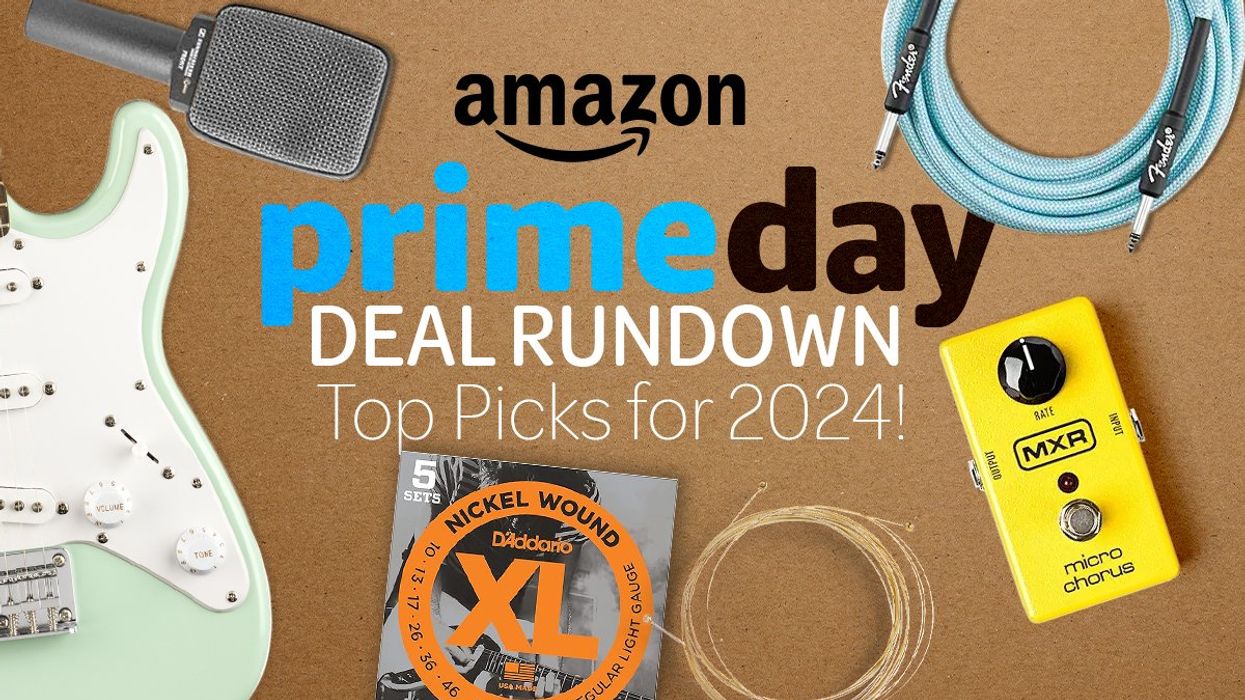
![Rig Rundown: Russian Circles’ Mike Sullivan [2025]](https://www.premierguitar.com/media-library/youtube.jpg?id=62303631&width=1245&height=700&quality=70&coordinates=0%2C0%2C0%2C0)








